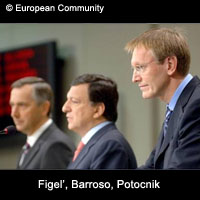Commission adopts EIT proposal in time for Lahti summit
The European Commission has adopted a proposal on establishing a European Institute of Technology (EIT), which Commission President José Manuel Barroso is hoping will receive the approval of the EU's Heads of State and Government when they meet informally in Lahti, Finland, on 20 October. The doubt connected with the project when it was first announced has been overcome, according to Mr Barroso, who presented the proposal with Science and Research Commissioner Janez Potocnik and Education, Training, Culture and Multilingualism Commissioner Jan Figel'. He declared that the EIT will 'help to break down the walls between research, education and business', and thus represents 'a European solution for a European problem'. He also described the Institute as a 'flagship for European innovation'. Creating an EIT was first proposed by the Commission President in February 2005. Since then, a number of potential structures have been examined, with stakeholders able to provide feedback via a consultation. The structure outlined in the proposal has two levels: a governing board that will be the EIT's legal entity, and Knowledge and Innovation Communities (KICs). The EIT itself will have around 60 scientific and support staff plus a 19-member Governing Board comprising 15 high-profile people from business and the scientific community and four members representing staff and students from the KICs. The KICs were described by Jan Figel' as 'more than a loose network'. They will bring together universities, research organisations and businesses within an integrated partnership. The partnership should then contribute to all three aspects of the 'knowledge triangle': research, innovation and education. The success of the EIT is partially dependent upon industry, as the EIT will rely on at least some of its funding coming from the private sector. Mr Barroso does not think that this will be a problem. He told journalists that he has met with CEOs from several major companies, all of whom have offered their support. Mr Figel' backed up this statement, listing at least 12 companies that are behind the EIT. They include Siemens, Unilever, Nokia, British Petroleum and Eriksson. The Commission views the EIT as a form of public-private partnership, and hopes that funding will mirror this image. On the public sector side, funding will come from a number of budgets but will not have its own EU budget line as it was not included in the Financial Perspectives - the approved EU budget for 2007 to 2013. The Commissioners listed the Seventh Framework Programme (FP7), the Competitiveness and Innovation Programme (CIP) and the Structural Funds as examples of funding sources which could be open to the EIT on a normal competitive basis. Other external sources of funding are listed in the proposal as: - Member State, regional or local authorities; - venture capital, banks (including the European Investment Bank); - resources resulting from its own activity (for example intellectual property rights); - resources from any endowments that the EIT accumulates. The Institute's budget for the period 2008 to 2013 is estimated at €2.4 billion, coming from the full spectrum of sources, while an initial start-up envelope of around €300 million will come from the Community budget. 'This is only the beginning, but we have the fullest confidence in our ability to come up with the money,' said Mr Barroso. 'We count on private input. But the place and money are not the first conditions for success. We should focus more on ideas and the concept and then the money will come,' added Mr Figel'. The proposal states that the EIT's legal structure should be set up by 2008, and the Institute would then become operational in 2009. Mr Barroso expects the majority of Member States, if not all of them, to back his proposal in Lahti. 'I don't know any Member State where private funding for research is not encouraged, or where public-private partnerships are not encouraged. So I don't know why they would support it at national level and not European level unless they don't want the European idea to work, the European dimension to prosper,' said the Commission President.



